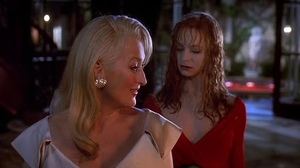Death Becomes Her

A self-described outsider, Robert Zemeckis came of age in the 1960s, when television was reshaping the American imagination. While others tuned in, he looked behind the screen, finding escape in the mechanical intricacies of filmmaking and a growing fascination with illusion. At USC’s School of Cinematic Arts, where his student work caught the attention of Steven Spielberg, Zemeckis began refining a distinctive blend: sentimental storytelling instincts paired with an obsessive drive toward technical experimentation. His early collaborations with writing partner Bob Gale bristled with a brash, kinetic energy – equal parts screwball comedy and subversive Americana. The turning point came in 1985 with Back to the Future, which elevated him from promising talent to household name.
A pop-cultural juggernaut and a masterclass in narrative construction, Back to the Future achieved a seamless fusion of comedy, fantasy, and character, standing to this day as one of the defining achievements of the blockbuster era. Its runaway success granted Zemeckis rare creative freedom, which he channeled to develop Who Framed Roger Rabbit (1988), a technical marvel that combined live-action and animation into a singular vision of noir satire. The film cemented Zemeckis as both innovator and entertainer. He followed with two BTTF sequels in rapid succession, maintaining an unbroken streak of commercial success and building momentum toward what would become his most visually daring and thematically elusive work.
By the early 1990s, Zemeckis had become a brand unto himself: reliable, accessible, and technically ahead of the curve. With Death Becomes Her, released in the summer of 1992, he appeared poised to continue that trajectory. The film, a dark comedy centered on vanity and immortality, follows two lifelong rivals in an escalating struggle over beauty, youth, and relevance. With a marquee cast and full studio backing from Universal Pictures, expectations were high. Audiences, however, were met with something colder, stranger, and more conceptually brittle than anticipated.
The story begins in 1978, as fading actress Madeline Ashton (Meryl Streep) seduces and marries respected plastic surgeon Ernest Menville (Bruce Willis), who had been engaged to aspiring writer Helen Sharp (Goldie Hawn). Seven years later, Helen is institutionalized, consumed by her hatred for Madeline and obsessed with revenge. Emerging from her breakdown with renewed confidence and a bestselling novel, she re-enters society transformed. Meanwhile, Madeline’s marriage has collapsed. Desperate to preserve her looks, she cycles through increasingly extreme cosmetic procedures, while Ernest – broken, alcoholic, and professionally diminished – now works as a mortician for high-society funerals, embalming the wealthy dead instead of healing the living.
Another seven years pass. At Helen’s glamorous book party, she appears radiant and untouched by time, shocking Madeline into panic. Her trusted surgeon offers no solutions, referring her to Lisle Von Rhuman (Isabella Rossellini), an ageless socialite living in a lavish, mysterious mansion. There, Madeline is offered a magical potion that promises eternal youth. She drinks it and is instantly revitalized, but Lisle offers one final warning: treat your body with care, because it is the only one you will ever have.
Madeline returns home in triumph, only to find that Ernest has rekindled his connection with Helen. Enraged, she provokes him into an argument. In a moment of fury, he pushes her down the stairs. Her neck brutally snaps, and her limbs grotesquely contort. Believing she has died, Ernest reels in horror – until she rises. Though disoriented and badly mangled, she remains alive. The catch becomes clear: while the potion grants eternal life, it leaves the body susceptible to injury. No wounds heal, no damage reverses. The body remains a fragile husk – suspended in time yet vulnerable to every break and bruise.
Helen arrives soon after, and the two women engage in a ghoulishly comic battle: firing shotguns, smashing heads, and cracking bones – eventually recognizing they share the same fate. Both immortal and decaying, they form an uneasy truce and beg Ernest, with his skills in cosmetic restoration, to repair and maintain their deteriorating bodies indefinitely. When he refuses, repelled by their condition and the implication of their request, they attempt to coerce him into taking the potion. In a final act of self-determination, Ernest escapes Lisle’s estate, fakes his death, and disappears – choosing a finite, mortal life over an eternal, empty one defined by artifice.
What begins as Hollywood satire gradually transforms into a macabre fable, with Zemeckis pushing his visual vocabulary into the surreal. The film adopts a comic-book aesthetic where exaggeration becomes both style and substance. Its most iconic set piece – Madeline walking around with her head twisted backward – is a landmark in digital effects, pioneering advancements in CGI face tracking and compositing. As the story hurtles toward its conclusion, Madeline and Helen devolve into patched-up relics, permanently mocking the world that once adored them. In their endless rituals of preservation lies a deeper horror – the pursuit of eternal youth is its own slow, humiliating form of decay.
Upon release, Death Becomes Her divided critics and underwhelmed theatergoers. Its technical brilliance earned universal praise but its chilly, acidic tone confounded viewers seeking warmth and redemption. Over time, however, the film found new life, embraced by audiences drawn to its camp sensibilities, baroque excess, and theatrical flair. More than thirty years later, its commentary on beauty culture feels uncannily prescient, less like exaggeration and more like foresight. In an age of AI filters, digital de-aging, and synthetic influencers, the film reads as warning rather than fantasy.
Death Becomes Her remains Zemeckis’s most cynical and conceptually radical experiment. It is the work of a filmmaker at the height of his powers willing to challenge and alienate in pursuit of innovation. The director would go on to achieve even greater box office success and industry recognition yet never returned to this level of tonal risk and conceptual boldness. In hindsight, Death Becomes Her plays as both detour and diagnosis; less celebrated, but more revelatory. Beneath the gloss, it is a film that strips away illusion to confront the rot within and refuses to flinch, with an honesty that endures.

